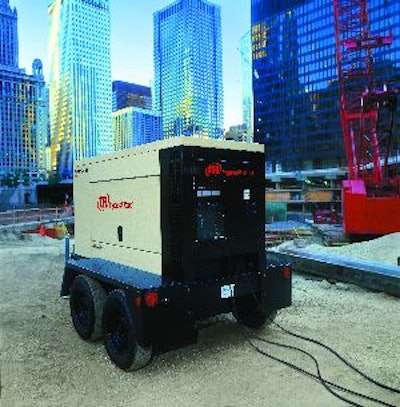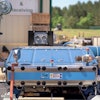
When concert-goers spend big money on tickets to hear America's latest idols perform on stage, they expect to hear top-quality vocals ? without a generator humming in the background. Some entertainment events and film productions, along with live broadcasts, require the rock star performance of a generator with an incredibly low-noise level, under 50 dB at 50 feet, (and, of course, a higher price).
But for most rental applications, about 70 dB to as few as 58 dB at about 23 feet will meet a customer's sound attenuation needs for diesel-powered towables. Gasoline-powered portables ranging from 3 kW to 15 kW will be noisier, closer to 72 and 74 dB at about 23 feet, because they do not have an enclosure, or housing, according to Chris Habic, co-owner of Gillette Generators, which is known for its large assortment of portable generators. For that reason, he says sound attenuation, or sound reduction, really comes into play starting at about 15 kW.
The rental house that can offer its customers a quieter generator will have a competitive advantage, says David Dahlstrom, director of sales and marketing for Shindaiwa Inc., which is known for its Kwiet Power brand diesel generators ranging from 20 to 150 kW. The more quiet a generator is, the more useful it becomes for different applications, from powering a county fair midway or a local band concert to meeting the changing needs of today's contractors.
"What makes a piece of equipment good for a rental company is one that has a lot of utilization," says Todd Howe, Doosan Infracore Portable Power product marketing manager for generators. Doosan Infracore Portable Power's full line of Ingersoll Rand PowerSource mobile generators provides power ranging from 10 kW to 450 kW.
Howe estimates about 80 percent of its gasoline-powered portable and diesel-powered mobile generators start their life in the rental environment.
"We're finding the trend with rental companies has been to go to quieter and quieter sound levels to increase the versatility and utilization of the product."
Local noise control ordinances have helped encourage this trend. An ordinance in Montgomery County, MD, is one example. Between the hours of 7 a.m. and 5 p.m., Monday through Friday, noise from construction activities must not exceed 75 dBA, measured at the nearest receiving property line (the receiving property is any property where people live or work and where noise is heard), but no less than 50 feet from the source. Several construction activities, such as demolition or pile driving, might inherently exceed 75 dBA, depending on the circumstance. In those cases, the ordinance allows up to 85 dBA, provided a Noise Suppression Plan, approved by the Department of Environmental Protection, is implemented. At times other than 7 a.m. to 5 p.m. weekdays, construction activities must meet the residential standard of 65 dBA during the daytime and 55 dBA at night, and non-residential standards of 67 dBA during the day and 62 dBA at night. Among the tips that the county offers contractors for complying with the noise ordinance is "when renting, specify the quietest equipment available. Low noise equipment is often of better quality and durability."
Local ordinances will usually vary from one community to another. At night, when generators might be needed to run dehumidification equipment, lights or submersible pumps, for example, noise ordinances are usually stricter. Typically there are more noise restrictions in more populated, urban areas. Hospitals and schools also can have noise restrictions (that primarily impact standby units, not rentals during power outages).
On a jobsite, Habic points out the generator is not usually going to be the largest producer of sound. Air compressors (regulated to 76 dBA by the federal Noise Emission Standards for Construction Equipment), cement trucks and excavators breaking up concrete, for example, will be louder.
Primarily, local ordinances like Montgomery County's are concerned with the overall noise created at a jobsite. To help reduce ambient noise on a jobsite, Howe says it's easier to control the noise level of a generator than it is a truck driving around the jobsite, for example.
Sound technology
As Habic mentioned, the first way to lower the sound of a generator is to put it inside an enclosure. The density, amount and placement of insulation, or foam, inside the generator housing further traps noise emitted from the engine body.
To reduce sound levels, manufacturers must look at the sound emission points ? what's making noise? Looking at a diesel engine, the two biggest noise sources are the air intake (baffles can redirect noise and provide a surface for sound-absorbing foam) and the exhaust (muffler systems with acoustical material can cancel high and low noise frequencies as much as possible). A secondary noise is the mechanical sound from the engine coming through the engine block.
From a high-level view, Marc Leupi, product manager at Wacker Neuson, says generator manufacturer sound attenuation solutions look similar, but there is no easy solution. Wacker Neuson's full line of mobile and portable generators designed for a variety of rental applications includes mobile generators ranging from 19.5 to 124 kW and two lines of portable generators (with the premium line in 13 models ranging from 2500 to 9700 Watts and a value line ranging from 2500 to 6600 Watts).
"If you had a generator inside a sealed box, you would really cut down on the engine noise," he says describing the engineering challenges. "The problem is you then have no cooling and no intake air and no exhaust."
New engines meeting the latest EPA regulations burn off particulates by running the engines hotter. The OEM challenge is to cool an engine properly without emitting more noise. It's an engineering fete that requires time and financial investment, Leupi says.
For sound attenuation, Howe summarizes there are three major considerations:
1) How quiet does the machine need to be?
2) What temperature does the machine need to be able to operate at?
3) How small does the package need to be?
All three are mutually exclusive and compete against one another, he adds.
Sound levels
How loud a machine is can be expressed in different ways. Typically, measuring sound pressure at 7 meters (about 23 feet) is standard for generators. Air compressor testing procedures, which are federally regulated, use this distance to measure sound. To come up with a decibel rating, Doosan Infracore Portable Power uses air compressor testing procedures. As Howe describes, five different microphones are positioned at each side of the machine and above the machine. Those measurements are used to determine an overall dB rating.
Dahlstrom says a true test for determining which of two generators is quieter is to put them side by side and Shindaiwa has done this with its kWiet power sound-attenuated mobile generators. The company's standard diesel models are in the 60 to 65 dB range and three Ultra-Quiet models are less than 60 dB. Shindaiwa's unique Ultra-Quiet technology uses air dams and insulated panels to redirect cooling air, doubling the length of travel to minimize airflow noise. On nearly every inside surface, including doors, special sound-absorbing material can be found. A specially tuned muffler and a longer exhaust pipe achieve an improved balance of high and low noise frequencies.
Many variables, including temperature, humidity and wind, can impact how loud or quiet a machine is. A lower load rating, say 25 percent capacity, will produce less noise than a machine that's operating at its 100 percent load rating. The surface a generator is on will impact the sound it makes. A hard surface tends to amplify noise more than a surface like grass, which will better absorb noise.
A sound future
While there's a gradual trend toward quieter units, there's still a lot of construction work being done by loud equipment and in rural areas, Leupi says.
Dahlstrom advises asking customers how important the noise created by the generator is. The rental application is key. Less noise is important for any kind of entertainment or outdoor event. On the other hand, if a contractor is working in a noise-sensitive area like a hospital, noise reduction can be even more crucial.
As more municipalities establish noise regulations, rental customers will require quieter generators, and as sound attenuation technology becomes less expensive for manufacturers or customers become willing to pay more, decibel ratings will further decrease. And that's a sound investment for our environment.
Measuring sound
Decibel ratings can be confusing. Sound travels in waves through the air. The greater the number of waves a sound has, the greater its frequency or pitch is. The strength of sound is measured in decibels (dB). Whether or not something is too loud can be debatable. The decibel scale, measuring sound pressure or energy according to international standards, shows how sounds rank according to the potential to harm hearing. Here are some examples of common sounds, their noise level and their effect:
http://www.forconstructionpros.com/images/newsimages/Table.jpg
Hearing begins at 0 dB and at 10 dB is just audible. To the ear, each 10 dB increase seems twice as loud because the decibel scale is logarithmic (based on powers of 10), it's not linear like a ruler. For example, 10 decibels is 10 times more intense than 1 decibel and 20 decibels is 100 times more intense. The reason measurements are done this way is that the human ear is sensitive to such a wide range of acoustic energy that the numbers involved needed to be compressed for convenience. Because the ear is able to detect a very slight change in noise, even a small reduction in decibels can make a difference.
Sound level meters have three or four scales for measuring noise. The A scale (with measurements expressed as dBA) is used most often to measure neighborhood noise. It electronically filters low and high frequencies and responds to sounds like the human ear does. How sound from generators should be measured is not federally regulated.




















